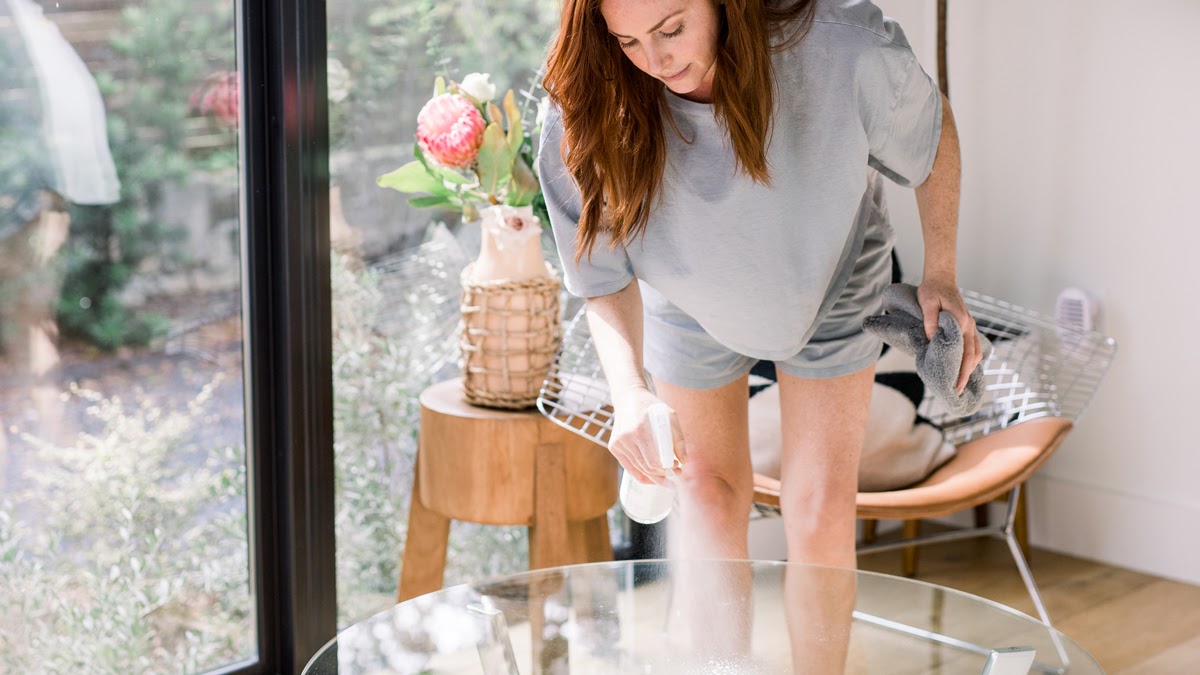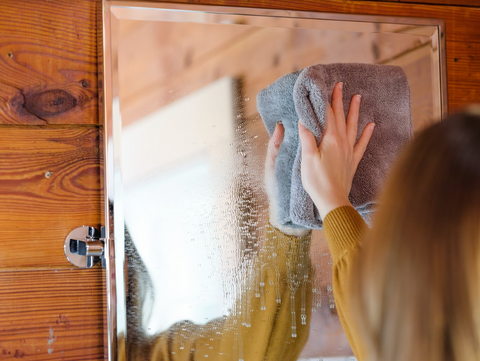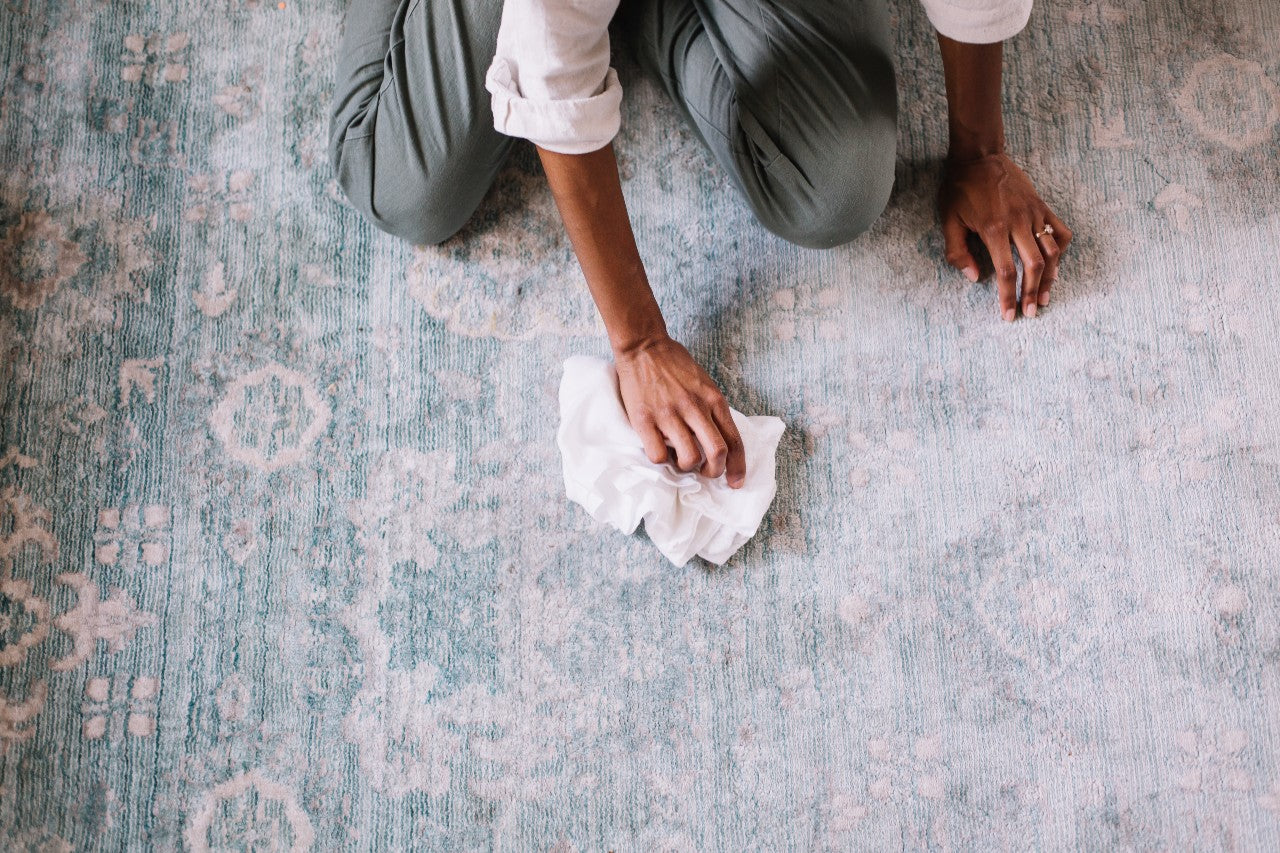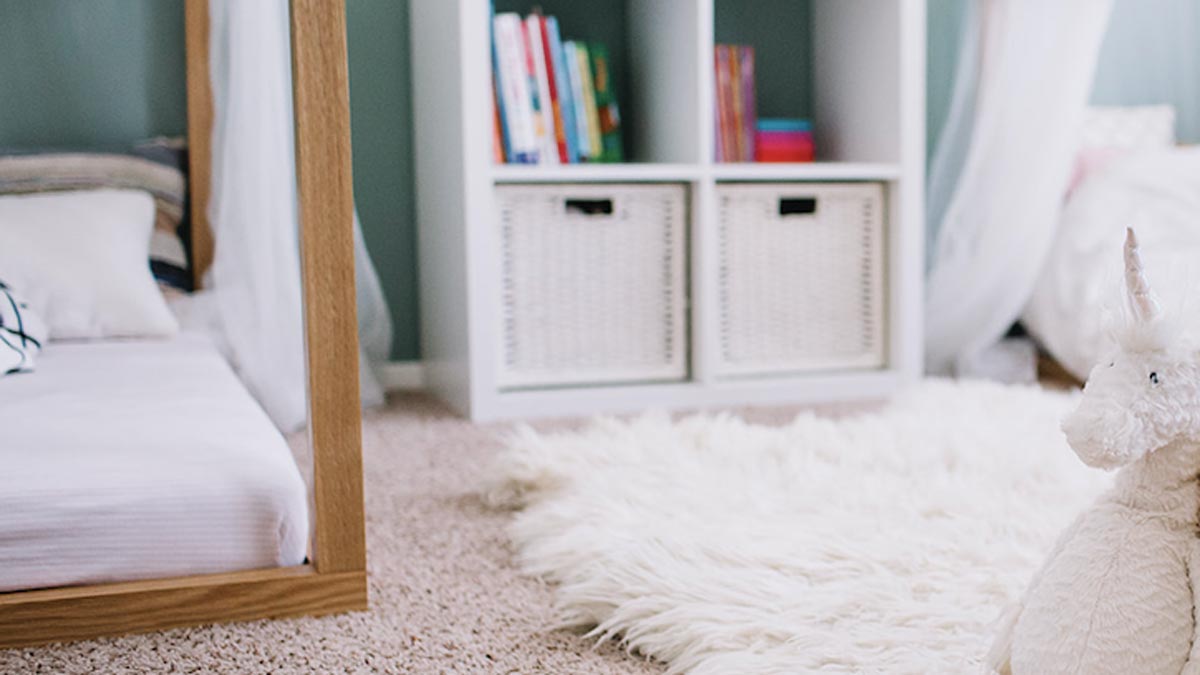
Cleaning 101: The Best Tips & Cleaning Products for Allergies
Sneezes and stuffy noses are a way of life for millions of Americans. And while we can do our best to remove allergens from our homes, what happens when you actually have an allergy to cleaning products?
To help alleviate your seasonal (or year-round) suffering, our guide not only outlines the best cleaning products for allergy sufferers but it also walks you through a new cleaning routine.
Can You Have an Allergy to Cleaning Products?

It’s not just dust and pollen that can cause sniffling and sneezing. Certain chemicals can aggravate allergies and other respiratory issues (like asthma):
1. Synthetic Fragrances

We equate floral or citrus smells with cleanness, but synthetic fragrances in cleaning products can result in respiratory problems, headaches, and skin irritation. Even more troubling? The FDA considers fragrance a “trade secret,” so companies aren’t required to disclose these ingredients. This means that you probably don't know what’s really in your cleaning products.
2. Ammonia

Often found in glass cleaners and liquid dish soaps, high concentrations of ammonia exposure can lead to burning of the throat, nose, and respiratory tract.
3. Bleach

Bleach is commonly found in disinfectants, laundry detergents, and various other cleaning products. In addition to skin irritation and poisoning, bleach inhalation can cause respiratory issues, resulting in throat irritation, coughing, wheezing, or shortness of breath.
4. Formaldehyde

Commonly used in shampoos and commercial cleaning products, formaldehyde (and formaldehyde releasers) are known to irritate the upper respiratory tract and skin.
5. Sodium Lauryl Sulfate

Sodium lauryl sulfate (SLS) is found in plenty of detergents, soaps, shampoos, and other foaming personal care items. There’s still more research to be done to assess the health risks of SLS exposure, but it may be linked to coughing, sore throat, and skin irritation (in individuals with sensitivities).
Reach for Cleaning Products for Allergy Sufferers

Allergies to cleaning products are a lot more common than people think. To reduce indoor allergens – and simultaneously get rid of questionable chemicals – why not replace them with hypoallergenic cleaning supplies?
Why Puracy Makes the Best Hypoallergenic Cleaning Products

Our formulas are tried and tested to harness the power of plant enzymes, the foaming properties of coconut-based cleansers, and they leave a delicate scent of plant-based essential oils. Plus, every Puracy product is free of:
- Animal byproducts
- Bleach & Chlorine
- Parabens
- Caustics
- Dyes
- Artificial fragrances & perfumes
- Phthalates
- Formaldehyde & formaldehyde releasers
- Phosphates
- Sulfates
16 Tips: Cleaning for Allergies

About 99% of homes have at least one detectable allergen and nearly 75% have between 3-6 detected allergen levels. Fortunately, it’s possible to reduce these particles with hypoallergenic cleaning products and simple, natural cleaning tips.
1. Stick to a Cleaning Schedule

Cleaning and disinfecting your home can seem like a daunting job. Our advice? Break your weekly cleaning schedule down into a few daily tasks to make it far more manageable (and ensure that you haven’t overlooked a room or a surface).
2. Cut Down on Clutter
 Home surfaces collect dust, and that means dust mites can really thrive there. Not only does reducing clutter keep spaces tidier but it'll also shorten your cleaning routine:
Home surfaces collect dust, and that means dust mites can really thrive there. Not only does reducing clutter keep spaces tidier but it'll also shorten your cleaning routine:- Give everything a place.
- During weekly cleanings, “rehome” misplaced items as you go (we like to keep a basket handy to speed up the process).
- Donate or sell unused items before bringing new ones into the home.
3. Wear a Mask

Whenever you dust or vacuum, wear a mask to avoid breathing in airborne particles. You can use an N95 or even an old t-shirt (as long as it covers your nose and mouth). If you're using a washable mask, throw it in the washing machine with a hypoallergenic laundry detergent.

This part is important: Don’t touch your face while cleaning. Next, immediately take a shower afterwards to remove dust from your skin and hair. We also recommend throwing your clothes in the washing machine.
4. How to Clean with Dust Allergies

You should be dusting at least once per week, but when you're cleaning for allergies, the products you use really matter. In fact, dry-dusting with rags and feather dusters helps spread particles throughout your home.
To collect and remove dust effectively, spray our Natural Surface Cleaner onto the surface of your choice (one trigger pull per 2’ x 2’ area). Using a clean, folded microfiber towel, wipe in a “Z” pattern. Voila!
5. Invest in the Right Products for Your Home...and Bed!

Your bed is an ideal spot for microscopic invaders to thrive, so if you regularly wake up with a stuffy nose, you might be responding to dust mites. These tiny arthropods prefer warm, humid places like pillows, mattresses, and other upholstered surfaces. Both their bodies and waste are allergens – and they live off discarded flakes of human skin. We know, it's gross.
You probably can't remove or prevent all dust mites, but you can reduce their numbers by removing their "food" source:
- Use zippered, allergen-proof pillow protectors and mattress protectors.
- Wash blankets, sheets, and pillow/mattress covers in hot water once a week.
- Even if you use a mattress protector, clean your mattress twice a year with your vacuum and a carpet cleaner.
- Manage the humidity in your home to make it less habitable for dust mites. Aim for less than 50%.
6. Vacuum Well & Vacuum Often

To remove indoor allergens on furniture and floors, vacuum once or twice a week. During allergy season, increase that frequency and use attachments to target curtains, blinds, and corners (and other less-obvious areas where dust tends to collect).
7. Choose the Best Vacuum for Allergies

When it comes to cleaning for allergies, a great vacuum is an absolute must. Using one that’s poorly-designed (and spews out dust) just doesn't make sense.
Look for a vacuum with a high-efficiency particulate air filter (HEPA). HEPA filters are mechanical air filters that remove at least 99.7% of airborne particles as small as 0.3 microns. For perspective, a single human hair measures around 80 microns.
Since emptying bagless models can create a dirt cloud, it's recommended to look for a vacuum that collects debris in a bag or bin.
Our Favorite Vacuums for Allergies
- Canister: The Miele Compact C1 Pure Suction comes with a sophisticated filter system that traps 99.9% of fine dust and offers six suction settings. This makes it ideal for all types of floors.
- Upright: The Shark Rotator Professional is a bagless vacuum designed for carpet and hard flooring. Containing a HEPA filter and anti-allergy seal technology to contain particles, this model is easy to maneuver around corners.
- Robot: The GOOVI HEPA 1600PA Robot offers powerful suction and remote and auto cleaning modes. Set it to clean at the same time every day and it’ll automatically return to the base when it needs charging.
- Cordless: The Dyson V10 holds a powerful charge for upwards of 35 minutes. Great for hardwood and carpets, its fully-sealed filtration system traps 99.99% of particles.
8. How to Clean Carpets for Allergies (& a Deeper Clean)

At some point (at least once a year), your carpets will need a deeper clean to remove pollen, dust, and grime – but so many carpet cleaning products contain ingredients like sulfates, bleach, petrochemicals, formaldehyde, and artificial fragrances.
Our 99.36% natural Carpet & Upholstery Shampoo isn't just hypoallergenic: It's also loaded with plant-based enzymes to lift away odors and stains.
How to Shampoo Your Carpets
You can shampoo washable surfaces by hand or invest in a carpet cleaning machine for a far more thorough clean. If someone in your home suffers from serious allergies, it might be worth investing in a budget-friendly carpet shampooer.
To avoid mold growth, ensure that the carpet fibers are fully dried before replacing furniture.
9. Watch out for Mold

Mold tends to thrive in warm, damp places (e.g. showers, under kitchen sinks, in HVAC units). There are also thousands of varieties of mold which can cause breathing problems and trigger asthma attacks.
Mold is less likely to grow when indoor moisture is controlled, so:
- Mop up spills immediately
- Use humidifiers if your home has high moisture levels
- Turn on exhaust fans in bathrooms after bathing
If You Spot Mold...
After cleaning the area with non-toxic surface spray (to remove surface dirt), follow-up with a diluted bleach solution or a commercial product that’s specifically designed to kill fungus. Always follow usage instructions and ventilate the area before and after cleaning.
Pro Tip: DO NOT attempt to remove black mold. If you spot large areas of mold and/or you suspect black mold, consult a professional immediately.
10. Keep the Outside Outside

Fresh air is nice, but it might be best to keep windows closed when your area is experiencing high pollen counts. If you can’t resist, consider cracking a single window open to reduce the flow of pollen coming into your home. Also consider:
- Machine-drying clothes and bedding instead of line-drying.
- Keeping shoes, coats, backpacks, and bags in a separate mudroom/storage area.
- When washing windows, keep one open at a time.
- After doing yard work – or spending time outside – take your clothes off at the door, throw them in the washer, and immediately take a shower.
11. Invest in an Air Purifier
Air purifiers remove microscopic particles from the air, and from commercial air sanitizers to smaller, portable models, there’s one for every budget. Asthma- and allergy-friendly models are recommended since they meet strict indoor health standards.
Pro Tip: We suggest using MERV-10 (or better) air filters in your HVAC systems. Consult the owner’s manual to select the right one.
12. Keep Skin Moisturized

Combat dry skin by keeping products around the house that will keep your hands and the rest of your body well moisturized. Healthy, hydrated skin is a must for those with allergies. During colder months, the drop in temperature can exacerbate dry skin, and frequent hand washing can leave hands chapped or flaking.
Our Natural Hand Soap features a gentle, hypoallergenic formula that is also effective and tough on germs and bacteria. Maintain your hands' moisture by following it up with our Organic Lotion, which nourishes and protects hands with ingredients like Vitamin E, Shea Butter, and aloe vera.
13. Dust with Microfiber Cloths

Not only are microfiber towels more effective and more absorbent when it comes to cleaning surfaces, but they're also better for those with allergies and other skin sensitivities. They collect dust better than an average feather duster or cotton rag, and once you're finished, you can simply toss them in the washing machine. They’re the ideal cleaning tool for those with allergies or other skin sensitivities.
Check out our Edgeless Microfiber Towels for 3x the fiber density and a hyper-absorbent design, making it the perfect cleaning sidekick for tackling dust, delicate surfaces, streak-free windows, and more.
14. Choose Latex-Free Gloves

If you’re doing a deep clean of your house and want to protect your hands, opt for cleaning gloves that don’t contain latex. Latex can often trigger skin sensitivities and lead to rashes or other irritations, while others have latex allergies. So what are your allergy-friendly options that still allow for sustainability? You can find biodegradable gloves that don't contain latex but are also still eco-friendly and recyclable.
15. Keep Your Home Allergy- and Pet-Friendly

Even if you have a hypoallergenic dog breed, you need to make sure your four-legged friend is regularly bathed and washed to avoid dander and the build-up dander between washes. After all, who says those with allergies can’t have a pet?
Our Natural Pet Shampoo & Conditioner uses coconut-derived ingredients to maintain the pH-balance of your pet's skin, while fortifying their coat with ingredients like biotin and oatmeal-derived moisturizers. The end result is a clean and happy pup that won’t trigger allergies or any other skin sensitivities.
16. Don’t Forget Kids Toys!

Though we may remember to regularly clean sheets, carpets, and rugs that can attract dust and dander, we may forget other objects that can just as easily contain allergens. Kids toys such as stuffed animals and fabric or plush toys can also harbor dust mites and other allergens. You can usually clean them by tossing them in the washing machine, so be sure to do this regularly.
Also watch out for bath toys or other toys that regularly are exposed to water, as they can build up mold or mildew. Check out our Guide to Cleaning Indoor and Outdoor Toys for more tips on keeping our children’s favorite playthings clean and allergy-friendly.
The Best Cleaning Products for Allergies Are at Your Fingertips

We weren't satisfied with creating the best hypoallergenic cleaning products: Our biochemists were tasked with developing the best cleaning products, period. In fact, we're so confident that you'll love our entire lineup, they all come with a 100% money-back guarantee.
We work with a team of biochemists, doctors, and cleaning experts to ensure that all of our products’ formulas are hypoallergenic and feature ingredients that are natural and plant-powered. That means we steer clear of harsh chemicals, synthetic fragrances, and other components that can trigger allergies. Next time you want to upgrade your cleaning routine and make it allergy-friendly, count on Puracy for safe, effective cleaning solutions that’s gentle on sensitive skin and safe for those with allergies.



























